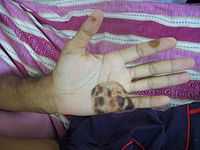Osler's node

Osler's nodes are painful, red, raised lesions found on the hands and feet. They are associated with a number of conditions, including infective endocarditis, and are caused by immune complex deposition. They are named after Sir William Osler who described them in the early 20th century.[1][2] Their presence is one definition of Osler's sign.[3]
Causes
Osler's nodes result from the deposition of immune complexes.[4] The resulting inflammatory response leads to swelling, redness, and pain that characterize these lesions.
The nodes are commonly indicative of subacute bacterial endocarditis.[5] 10–25% of endocarditis patients will have Osler's nodes. Other signs of endocarditis include Roth's spots and Janeway lesions. The latter, which also occur on the palms and soles, can be differentiated from Osler's nodes because they are nontender.[4]
It can also be seen in
- Systemic lupus erythematosus
- Marantic endocarditis
- Disseminated gonococcal infection
- Distal to infected arterial catheter
External links
References
- ↑ synd/1702 at Who Named It?
- ↑ Osler, W (1908–1909). "Chronic infectious endocarditis". Quarterly Journal of Medicine (Oxford) 2: 219–230.
- ↑ "Osler sign" at Dorland's Medical Dictionary
- ↑ 4.0 4.1 Farrior, JB; Silverman, ME (August 1976). "A consideration of the differences between a Janeway's lesion and an Osler's node in infectious endocarditis" (PDF). Chest 70 (2): 239–43. doi:10.1378/chest.70.2.239. PMID 947688.
- ↑ "Osler nodes" at Dorland's Medical Dictionary
| ||||||||||||||||||||||||||||||||||||||||||||||||||||||||||||||||||